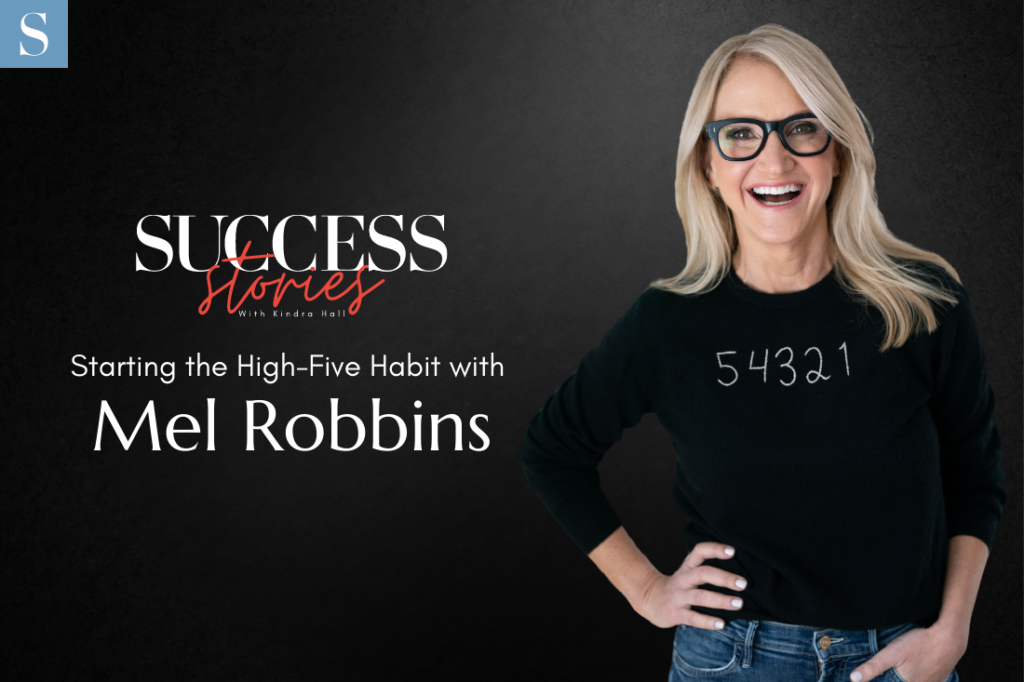Changing your outlook on life doesn’t have to be complicated. It can start with a simple habit—one that steers you away from stress and toward optimism.
Mel Robbins has that habit for you, and she knows it might sound weird.
In her best-selling self-published second book, The 5 Second Rule: Transform Your Life, Work, and Confidence with Everyday Courage, Mel taught us to deal with crises by counting backwards from five. In her third book, The High 5 Habit: Take Control of Your Life with One Simple Habit, she introduces a new tool: high-fiving our own reflections.
On a particularly difficult morning, Mel dragged herself out of bed, and when she saw herself in the mirror, she spontaneously gave herself a high-five.
“I felt this energy, like, ‘For God’s sake, pull it together and just get out there and deal with it,’” she says. “Get-your-head-back-in-the-game kind of energy.”
In this episode of SUCCESS Stories, Mel tells Chief Storytelling Officer Kindra Hall why a high-five is such a powerful gesture of self-love, why it’s OK if it feels a little weird at first, and why we shouldn’t reserve self-care for the moment we finally achieve our goals.
Show up for yourself the same way you do for other people.
If a friend is having a hard time, we find it natural to give them a hug, tell them they have the skills and resilience to make it through, and offer them support along the way.
If we’re the one worrying about the future and stressed about the present, we find it much harder to locate the light at the end of the tunnel. If anything, we tend to blame ourselves, which only makes us feel worse about an already difficult situation.
The first step of Mel’s High 5 Habit is to look at yourself in the mirror. When you can see your own reflection, it’s easier to think about yourself as a separate person—someone you would support through a challenge.
Once you’re in front of the mirror, give yourself a high-five.
You’ve probably performed this gesture hundreds of times before. Your brain subconsciously knows what a high-five means: celebration, reassurance, teamwork, determination.
So when you give your reflection a high- five, your brain automatically gives you that little thrill you get when you do it with someone else. It tells you that you’re cheering on the person you’re high-fiving—in this case, yourself.
We know how to support others, and how to come together in moments of struggle and triumph. A high-five with your reflection reminds you that you are worthy of the same love and compassion you gladly show to the other people in your life.
Accepting your own high-five might feel strange.
Mel understands that this is a novel approach. The first time she impulsively gave her reflection a high-five, she burst out laughing because it felt so cheesy.
She says that’s one of two reactions people typically have to high-fiving their reflections for the first time. Another is crying. When people suddenly show themselves self-compassion after years of self-criticism, they realize how lacking this habit has been in their lives up to that point.
Facing yourself in the mirror can be an intimidating experience. Not because of the things you don’t like about your reflection, but because it makes you take stock of all the life experiences you’re carrying around. That includes sad things that have happened to you, and bad things you’ve done that you haven’t forgiven yourself for.
That’s why a high-five is such a perfect gesture for repairing that relationship with yourself. It’s lighthearted, but it also means something serious: We’re on the same team, and I’m going to be here for the struggles and the celebrations.
Given the surprising emotions that might come up, Mel recommends trying the High 5 Challenge for five days to begin with, so you can get used to the weirdness, and start to see the effects.
You don’t have to earn the right to self-care.
A mistake many people make when they’re thinking about setting goals is believing that that’s the way we earn self-respect and self-compassion. But the moment you achieve your dream is not the moment when you most need to feel that sense of belief in yourself.
It’s during the long and difficult journey to those goals that you most need to remind yourself that you believe in your own abilities. If you tie your right to self-care and self-love to achieving your goals, you’ll run out of steam to get to them.
By practicing the High 5 Habit, you can give yourself that boost of self-belief every day, including at the times when you’re furthest from reaching your targets, and most need a helping hand.
Believe that you can make it through this.
Everyone has moments in their lives when they just can’t see a way out of a bad situation. Instead of letting that feeling drag you under, try to understand that it’s preparing you for an opportunity that will come your way if you keep going.
Mel calls this anchoring into optimism: when you choose to see the most difficult times of your life as a lesson, rather than something that will trap you forever.
That’s not to say you aren’t allowed to feel sad and angry. It’s important to acknowledge and honor those emotions. But don’t let them become the overwhelming story of your life. Keep going, show yourself love and support, and find out what you were supposed to learn from this challenge.
SUCCESS Stories with Madison Pieper is no longer releasing new episodes on the SUCCESS Podcast Network, but you can still listen to the full conversation below.




